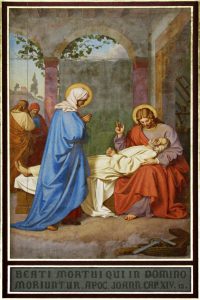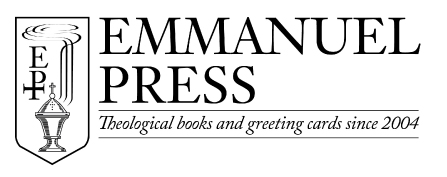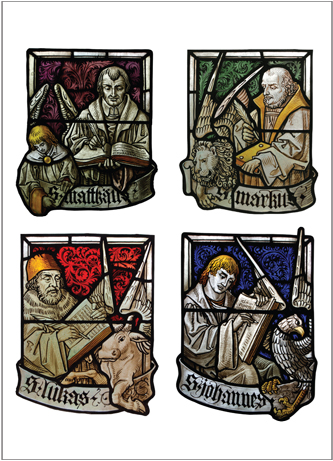An Explanation of the Common Service: The Benediction

The Benediction
The Lord bless thee, and keep thee.
The Lord make His face shine upon thee, and be gracious unto thee.
The Lord lift up His countenance upon thee, and give thee peace.
__________
What is the Benediction? It is the final blessing of the people, commanded by God (Numbers 6:22-26), and always regarded by the Church as one of the most solemn parts of the Service. Says an ancient writer: “When the Benediction is pronounced, you should incline both head and body, for the blessing which is given you is the dew and rain of heaven.”
What is the nature of the Benediction? It is not a mere pious wish, but is the actual impartation of a blessing from God to the believing congregation, as we are assured in Numbers 6:27, “They [the priests] shall put my name upon the children of Israel, and I will bless them.” Because of the singular pronoun “thee,” it is highly appropriate as the conclusion of the Communion, in which through the Sacrament, the Lord has bestowed His grace upon each believer.
__________
*an excerpt from An Explanation of the Common Service, pages 66-67. (on sale through August 31)
*picture above from our Benediction notecard
An Explanation of the Common Service: The Lord’s Prayer
Our Father, who art in heaven, Hallowed be Thy Name; Thy kingdom come; Thy will be done on earth as it is in heaven; Give us this day our daily bread; And forgive us our trespasses, as we forgive those who trespass against us; And lead us not into temptation; But deliver us from evil. For Thine is the kingdom, and the power, and the glory, for ever and ever. Amen.
__________
Why did the early Church introduce this prayer into the Communion Service [the second part: the Service of the Sacrament of the Altar]?
On account of its sacredness.
(a) From ancient times it has always been regarded as a divine and spiritual form of prayer, which can never fail to move our heavenly Father, because His Son taught us thus to pray. On this Cyprian says beautifully: “What prayer can be more spiritual than that which was given us by Christ, by Whom also the Holy Spirit was sent? What petition more true before the Father than that which came from the lips of His Son, Who is the Truth?”
(b) Its use was esteemed the peculiar privilege of true believers. Hence it was said, not in the first part of the worship [the Service of the Word], where we usually have it, but in the Communion Service, from which the heathen and catechumens (the unbaptized) were excluded. The latter were strictly forbidden to utter it. Chrysostom explains thus: “Not until we have been cleansed by the washing of the sacred waters are we able to call God, Father.”
_________
An Explanation of the Common Service, pages 57-58. (on sale through August 31)
*Read about bulk order pricing here.
Seed-Grains of Prayer: Prayer for Saturday Evening
“Heavenly Father, I praise Thee that, by Thy grace, I have been permitted to put another week of trials behind me, and have not been cast away in my sins together with the godless. O Lord, my God, Who ordainest and changest times and seasons, change also my heart and mind, by Thy Holy Spirit, that this week may mark a true change of time for me, to turn me from my former impenitence, my love for the world, and my lusting desires, unto Thee alone, through faith and love, so that, if this had been my last week on earth, I might lay aside this corrupt and sinful life, and put on the incorruptible, holy life in Christ. Amen.”
Wilhelm Loehe, Seed-Grains of Prayer, #250 (on sale through August 20)
An Explanation of the Common Service: An Excellent Resource for the Congregation
“An Explanation of the Common Service is an excellent resource. It is concise and informative, and it presents to laymen and clergy alike the simplicity and strength of the historic Lutheran Service used by most North American parishes prior to the 1970-80s. I have had only positive feedback from all who have used it. This book is a superb resource for both new members and life-long Lutherans.” Rev. William Parsons, Redeemer Lutheran Church in Fairhope, AL.
After several requests from pastors to order in bulk for their Sunday School and Adult Bible classes, we now offer discounted pricing for this book: orders of 10-20 books receive 15% off; 21-30 books receive 20% off; 31+ books receive 25% off.
In addition, we have extended the sale price for this book only to August 31 so that the bulk order discount can be applied to the current sale price. It’s basically a double discount. Contact us with your order so that we can create a customized invoice for you. Our website cannot compute the bulk order discount automatically.
__________
*From the back cover:
The Common Service, with roots in the Reformation, the Middle Ages, and the early church, became the standard English liturgy for the Lutheran Church in America in the late 19th century. The Lutheran Church—Missouri Synod published it as its standard in The Lutheran Hymnal in 1941. With the publication of Lutheran Worship (1982), editors revised the Common Service, updating what they considered archaic language, but the basic structure remained the same. In the Lutheran Service Book (2006), editors have again included the Divine Service from The Lutheran Hymnal, which is the liturgy of the Common Service.
What is it about the beauty and reverence of this Divine Service that have caused Lutheran congregations to welcome it every Sunday morning for over a century? Many today enjoy it without being able to verbalize its deep theological beauty. Others may exclude it from congregational practice because they consider it outdated and invalid for the modern parishioner. In either case, the editors of An Explanation of the Common Service provide a basic yet important description of the theological and biblical meaning of this time-tested liturgy.
An Explanation of the Common Service explains the liturgy in such simple terms that it is perfect for teaching new members, catechumens, and youth. Yet its timeless truths are profound enough to instruct even long-time members and pastors. First printed a century ago, this Lutheran liturgical handbook uses questions and answers to explain the meaning of three services: the Communion service, Matins, and Vespers. (Liturgical texts are equivalent to those in The Lutheran Hymnal, 1941.) In addition, hymnody, liturgical theology, and history are addressed succinctly. The glossary of liturgical terms is helpful, extensive, and reliable.
__________
*This is an edited re-post from 5/6/11.
An Explanation of the Common Service: The Kyrie
Why do we do what we do, sing what we sing, and pray what we pray in the Common Service (LSB Setting 3, TLH p. 15)? In the next few weeks, we will be posting several excerpts from An Explanation of the Common Service in order to “provide a basic yet important description of the theological and biblical meaning of this time-tested liturgy” (back cover).
_________
The Kyrie
Lord, have mercy upon us.
Christ, have mercy upon us.
Lord, have mercy upon us.
What is the meaning of the word Kyrie? It is a Greek word and means “O Lord.”
What is the office of the Kyrie? The congregation, realizing its infirmity from indwelling sin, calls upon God for that grace which has been announced and offered in the Introit.
Why is the prayer thrice uttered? Because the grace for which it asks is from God the Father, through the Son, by the Holy Spirit.
_________
An Explanation of the Common Service, pages 27-28. (on sale through August 20)
Seed Grains of Prayer: Prayer Before Daily Bible Reading
“Lord Jesus Christ, Who hast commanded to search the Scriptures and promised that in them we have the impulse of faith, and life everlasting; Who alone art worthy to open and break the sevenfold seals of this Book; open now mine eyes to behold the wonders of Thy law. Show me the paths of righteousness, that I continue therein unto the end. From heaven above, pour out Thy Holy Spirit upon me, and from Thy throne of glory send Him to be with me; to work in me that I learn to know what is well pleasing to Thee; to do all my labor in Thy name, unto Thy glory; and to fill my heart with true faith, love, hope, humility, long-suffering, fear, and blessedness in the Lord. Amen.”
Wilhelm Loehe, Seed Grains of Prayer, #16 (on sale through August 20)
August Sale: 20% off All Books
From now through Monday, August 20, all of our books (plus The Brotherhood Prayer Book Audio CD) are 20% off the retail price.
The Brotherhood Prayer Book: Hymn for Pentecost (with Audio)
Audio: Listen to Hymn for Pentecost chanted.
Come, Holy Ghost, Creator blest,
Vouchsafe within our souls to rest;
Come with Thy grace and heavenly aid
And fill the hearts which Thou hast made.
To Thee, the Comforter we cry,
To Thee, the Gift of God Most High,
The Fount of life, the Fire of love,
The soul’s Anointing from above.
The sevenfold gifts of grace are Thine,
O Finger of the Hand Divine;
True Promise of the Father Thou,
Who dost the tongue with speech endow.
Thy light to every thought impart
And shed Thy love in every heart;
The weakness of our mortal state
With deathless might invigorate.
Drive far away our wily Foe
And Thine abiding peace bestow;
If Thou be our protecting Guide,
No evil can our steps betide.
Make Thou to us the Father known,
Teach us the eternal Son to own
And Thee, whose name we ever bless,
Of both the Spirit, to confess.
Praise we the Father and the Son
And Holy Spirit, with them One;
And may the Son on us bestow
The gifts that from the Spirit flow.
Amen.
__________
Veni, creator Spiritus, mentes. Rhabanus Maurus, d. 856, trans. by E. Caswall.
**An excerpt from The Brotherhood Prayer Book
Now Available: The Four Evangelists Greeting Card
The Four Evangelists, our newest greeting card, is now available! As stated on the back of the card:
These stained glass images come from a village church in Zwingenberg, Germany. Christian tradition has historically associated the authors of the four Gospels with the four “living creatures” that surround God’s throne, as described in Revelation 4:7 – Matthew (S. Matthäus) with a man, Mark (S. Markus) with a lion, Luke (S. Lukas) with an ox, and John (S. Johannes) with an eagle. The four evangelists are traditionally represented in paintings, carvings, or stained glass near or on the pulpit to show that the Word preached by the pastor is a proclamation of Jesus’ own words as recorded in the Gospels.
While this blank card is appropriate for any type of correspondence, it is especially suitable for ordinations, installations, or an anniversary of these, whether it be given to a pastor or used as an invitation to one of these occasions.
As a reminder, please visit the Ordering Information tab for details about bulk orders, shipping, and international orders.
Coming Soon: The Four Evangelists Greeting Card
We are putting the finishing touches on a new greeting card of the four evangelists, featuring a stained glass window found in a village church near our former home in Germany. We plan to have this card available within the next few weeks.
While this card is appropriate for any type of correspondence, it is especially suitable for ordinations, installations, or an anniversary of these, whether it be given to a pastor or used as an invitation to one of these occasions.
May God bless the seminarians from Fort Wayne and Saint Louis who prepare to receive a call into the Office of the Holy Ministry this week.




